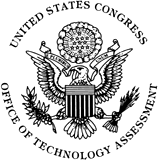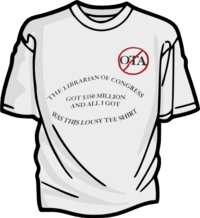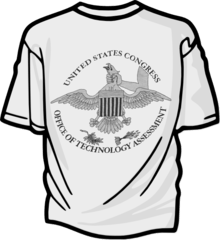Office of Technology Assessment
The Office of Technology Assessment (OTA) was an office of the United States Congress from 1972 to 1995. OTA's purpose was to provide Congressional members and committees with objective and authoritative analysis of the complex scientific and technical issues of the late 20th century, i.e. technology assessment. It was a leader in practicing and encouraging delivery of public services in innovative and inexpensive ways, including early involvement in the distribution of government documents through electronic publishing. Its model was widely copied around the world.

The OTA was dismantled in 1995, following the 1994 mid-term elections which led to Republican control of the Senate and the House. Republican legislators characterized the OTA as wasteful and hostile to GOP interests.
Princeton University hosts The OTA Legacy site, which holds "the complete collection of OTA publications along with additional materials that illuminate the history and impact of the agency". On July 23, 2008 the Federation of American Scientists launched a similar archive that includes interviews and additional documents about OTA.
History
Congress established the Office of Technology Assessment with the Technology Assessment Act of 1972.[1] It was governed by a twelve-member board, comprising six members of Congress from each party — half from the Senate and half from the House of Representatives. During its twenty-four-year life it produced about 750 studies on a wide range of topics, including acid rain, health care, global climate change, and polygraphs.
Closure


Criticism of the agency was fueled by Fat City, a 1980 book by Washington Times journalist Donald Lambro that was regarded favorably by the Reagan administration; it called OTA an "unnecessary agency" that duplicated government work done elsewhere. OTA was abolished (technically "de-funded") in the "Contract with America" period of Newt Gingrich's Republican ascendancy in Congress. According to Science magazine, "some Republican lawmakers came to view [the OTA] as duplicative, wasteful, and biased against their party."[2]
When the 104th Congress withdrew funding for OTA, it had a full-time staff of 143 people and an annual budget of $21.9 million. The Office of Technology Assessment closed on September 29, 1995. The move was criticized at the time, including by Republican representative Amo Houghton, who commented at the time of OTA’s defunding that "we are cutting off one of the most important arms of Congress when we cut off unbiased knowledge about science and technology".[3]
Critics of the closure saw it as an example of politics overriding science, and a variety of scientists have called for the agency's reinstatement.[4]
Subsequent developments
While the OTA was closed down, the idea of technology assessment survived, in particular in Europe. The European Parliamentary Technology Assessment (EPTA) network coordinates members of technology assessment units working for various European governments. The US Government Accountability Office has meanwhile established a TA unit, taking on former duties of the OTA.
While campaigning in the 2008 US presidential election, Hillary Clinton pledged to work to restore the OTA if elected President.[5][6] On April 29, 2009, House of Representatives member Rush Holt of New Jersey wrote an op-ed piece articulating the argument for restoring the OTA.[7]
In April 2010 The Woodrow Wilson International Center for Scholars released a report entitled "Reinventing Technology Assessment" that emphasized citizen engagement and called for performing the functions of the OTA by creating a nationwide network of non-partisan policy research organizations, universities, and science museums: the Expert & Citizen Assessment of Science & Technology (ECAST) network. ECAST would conduct both expert and participatory technology assessments for Congress and other clients. The author of the report was Dr. Richard Sclove of the Loka Institute. The report states that the drive to modernize OTA was initiated by Darlene Cavalier, a popular citizen science advocate and author of the Science Cheerleader blog.[8] Cavalier outlined the idea of the citizen network in a guest blog post for Discover Magazine's The Intersection.[9] She introduced the concept in an article in Science Progress in July 2008.[10] Andrew Yang became the first 2020 presidential candidate on April 4, 2019 to push for the idea to reestablish the OTA.[11] He did so with a detailed proposal that includes refusing to sign any budget that doesn't include the OTA.[12]
See also
References
- "Technology Assessment Act of 1972 ~ Public Law 92-484" (PDF). 86 Stat. 797 ~ House Bill 10243. U.S. Government Publishing Office. October 13, 1972. (HTML version)
- MalakoffApr. 30, David; 2019; Pm, 3:55 (2019-04-30). "House Democrats move to resurrect Congress's science advisory office". Science | AAAS. Retrieved 2019-05-01.CS1 maint: numeric names: authors list (link)
- Nader proposes reviving Congressional Office of Technology Assessment
- PZ Myers (September 14, 2007). "Bring back the OTA". Scienceblogs. Retrieved 2013-03-12.
- Patrick Healy; Cornelia Dean (October 5, 2007). "Clinton Says She Would Shield Science From Politics". The New York Times. Retrieved 2007-10-05.
- "Scientific Integrity and Innovation: Remarks at the Carnegie Institution for Science". October 4, 2007. Archived from the original on October 9, 2007. Retrieved 2007-10-05. Text of Clinton's speech to the Carnegie Institution.
- Holt, Rush (April 29, 2009). "Lobotomy". Wired. Retrieved 2009-04-29.
- Richard Sclove (April 2010). "Reinventing Technology Assessment: A 21st Century Model" (PDF). Woodrow Wilson International Center for Scholars. Archived from the original (PDF) on 2010-06-02. Retrieved 2010-05-05.
- Darlene Cavalier (April 29, 2010). "A Little Respect: Involving Citizens in Technology Assessment". Discover. Retrieved 2010-05-05.
- Darlene Cavalier (July 7, 2008). "Harnessing Citizen Scientists". Science Progress. Retrieved 2010-05-05.
- https://twitter.com/AndrewYang/status/1113862421830090752
- https://www.yang2020.com/policies/reviveota/
Further reading
- Bruce Bimber: Politics of Expertise in Congress: The Rise and Fall of the Office of Technology Assessment, State University of New York Press, 1996.
- Peter D. Blair, "Congress’s Own Think Tank", Palgrave Macmillan, September 2013.
- Zachary Graves and Kevin Kosar, “Bring in the Nerds: Reviving the Office of Technology Assessment”, R Street Institute policy study, January 2018.
- Chris Mooney, "Requiem for an Office", Bulletin of the Atomic Scientists, September 2005 vol. 61 no. 5 40-49.
- Chris Mooney, The Republican War on Science (New York: Basic Books, 2005), ch. 5.
- Jathan Sadowski, "The Much-Needed and Sane Congressional Office That Gingrich Killed Off and We Need Back", The Atlantic, October 26, 2012.
- Kim Zetter, "Of Course Congress Is Clueless About Tech-It Killed Its Tutor", Wired.com, April 21, 2016.
- Brooks, Chuck; Logsdon, David (November 16, 2016). "Congress had an office that gave expert tech analysis; let's bring it back". The Hill.
External links
- Office of Technology Assessment (OTA) Legacy via Woodrow Wilson School of Public and International Affairs at Princeton University
- OTA publications
- U.S. Congress, Office of Technology Assessment (1995). "Biologically based technologies for pest control" (PDF). Ota-Env-636.
- US Congress 1994. Perspectives on the Role of Science and Technology in Sustainable Development. OTA-ENV-609. NTIS order #PB95-109674. GPO stock #052-003-01396-7 Govinfo.library.unt.edu.
- OTA publications
- The Office of Technology Assessment Archive hosted by the Federation of American Scientists
- CyberCemetery OTA coverage "established ... to provide permanent, Web based, public access", a partnership of University of North Texas and the United States Government Printing Office
- Psychiatric Disabilities, Employment, and the Americans With Disabilities Act Background Paper. Behney, Clyde J. (Asst Director OTA Health, Life Sciences & Environment Division), Hall, Laura Lee, Keller, Jacqueline T. HTML converted from WordPerfect 5.1 to HTML in 1996 at Earth Ops Dot Org
- OTA Video "Meeting the Needs of Congress"